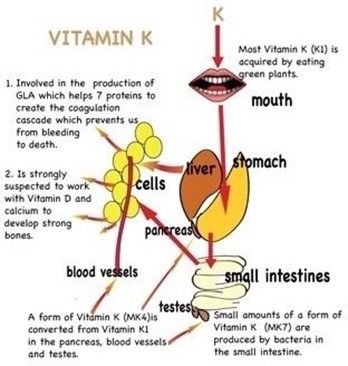The nurse administers vitamin K to the newborn for which reason?
Most mothers have a diet deficient in vitamin K, which results in the infant’s being deficient.
Vitamin K prevents the synthesis of prothrombin in the liver and must be given by injection.
Bacteria that synthesize vitamin K are not present in the newborn’s intestinal tract.
The supply of vitamin K is inadequate for at least 3 to 4 months, and the newborn must be supplemented.
The Correct Answer is C
Bacteria that synthesize vitamin K is not present in the newborn’s intestinal tract. Vitamin K is essential for blood clotting, and newborns are at risk of bleeding problems due to their lack of vitamin K. Therefore, vitamin K is given by injection to prevent hemorrhagic disease in the newborn.

Choice A is wrong because most mothers do not have a diet deficient in vitamin K, and vitamin K deficiency in newborns is not related to the maternal diet.
Choice B is wrong because vitamin K does not prevent the synthesis of prothrombin in the liver, but rather enhances it. Prothrombin is a clotting factor that requires vitamin K for its production.
Choice D is wrong because the supply of vitamin K is not inadequate for at least 3 to 4 months, but rather for a few days until the newborn’s intestinal bacteria start producing it.
Nursing Test Bank
Naxlex Comprehensive Predictor Exams
Related Questions
Correct Answer is D
Explanation
choice D. Make a follow-up home visit to parents as soon as possible after the infant’s death. This is because a competent, qualified professional should visit the family at home as soon as possible after the death and provide the family with printed information about SIDS.
Choice A is wrong because explaining how SIDS could have been predicted and prevented is inappropriate.
SIDS cannot be prevented or predicted. Discussions about the cause will only increase parental guilt.
Choice B is wrong because the parents should be asked only factual questions to determine the cause of death. Interviewing parents in-depth concerning the circumstances surrounding the infant’s death may be intrusive and stressful.
Choice C is wrong because parents should be allowed and encouraged to make a last visit with their infant. Discouraging parents from making a last visit with the infant may deprive them of an opportunity to say goodbye and grieve.
Correct Answer is D
Explanation
Digoxin is a medication that helps improve the pumping function of the heart and reduces fluid retention in the lungs and other tissues. It is commonly used to treat congestive heart failure in infants.
Choice A is wrong because weighing the infant every day on the same scale at the same time is a way to monitor fluid balance, not an intervention to treat excess fluid volume.
Choice B is wrong because notifying the physician when weight gain exceeds more than 20 g/day is also a monitoring measure, not an intervention. Moreover, weight gain may not accurately reflect fluid volume status in some patients with heart failure due to poor nutrition and decreased appetite.
Choice C is wrong because putting the infant in a car seat to minimize movement may worsen the respiratory distress and increase the workload of the heart. The infant should be positioned in a semi-Fowler’s or Fowler’s position to facilitate breathing and reduce venous return.
Whether you are a student looking to ace your exams or a practicing nurse seeking to enhance your expertise , our nursing education contents will empower you with the confidence and competence to make a difference in the lives of patients and become a respected leader in the healthcare field.
Visit Naxlex, invest in your future and unlock endless possibilities with our unparalleled nursing education contents today
Report Wrong Answer on the Current Question
Do you disagree with the answer? If yes, what is your expected answer? Explain.
Kindly be descriptive with the issue you are facing.
